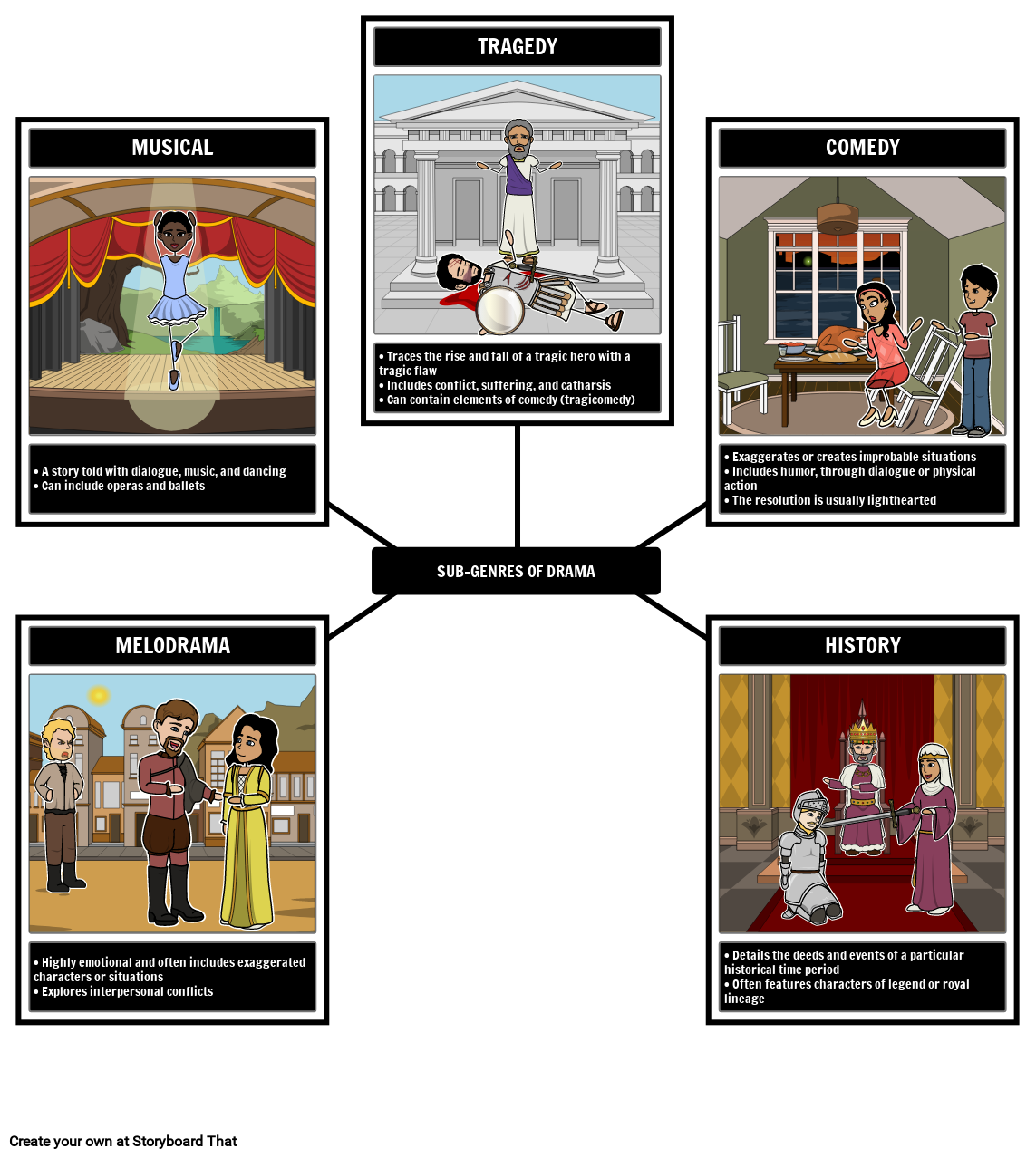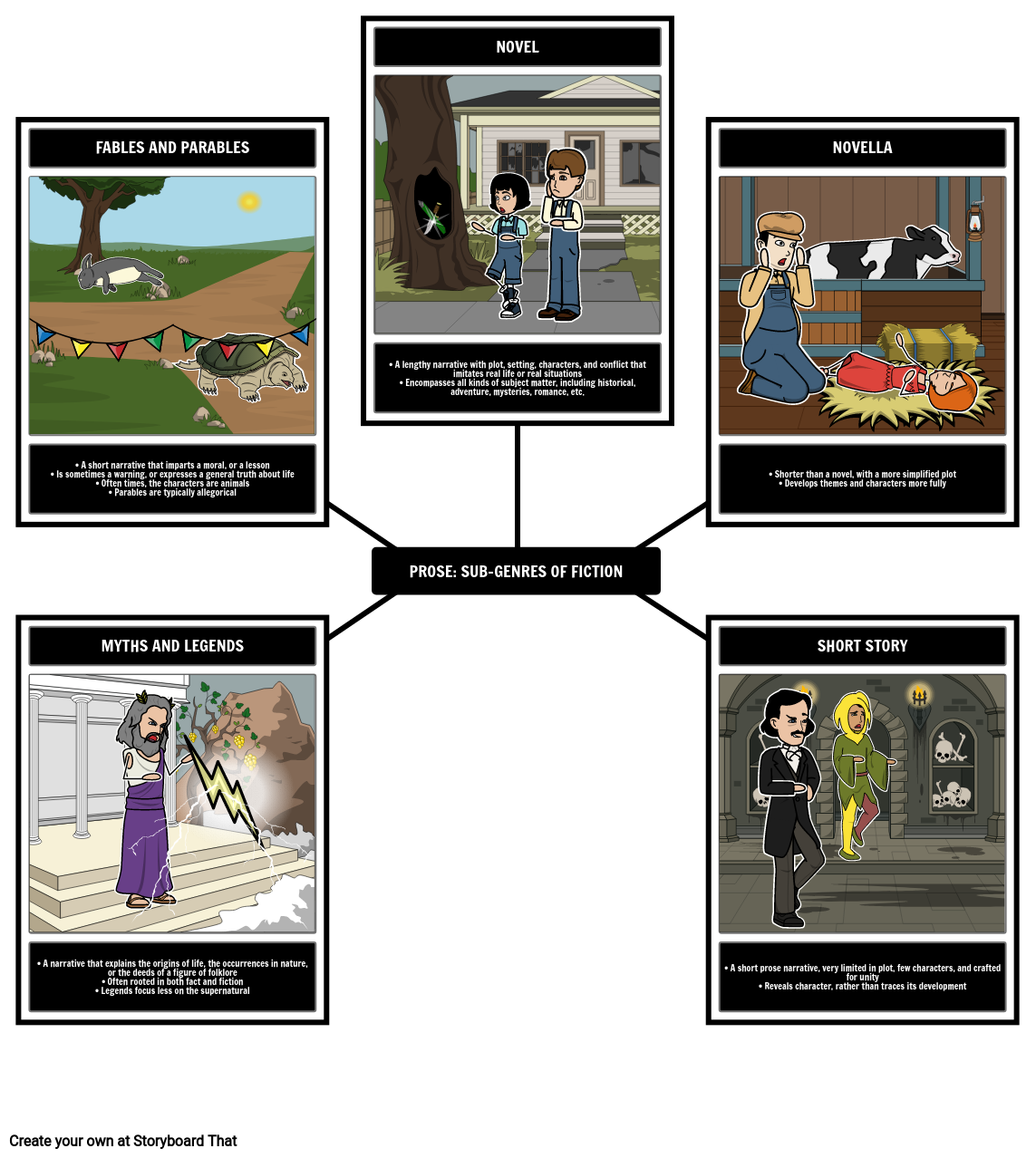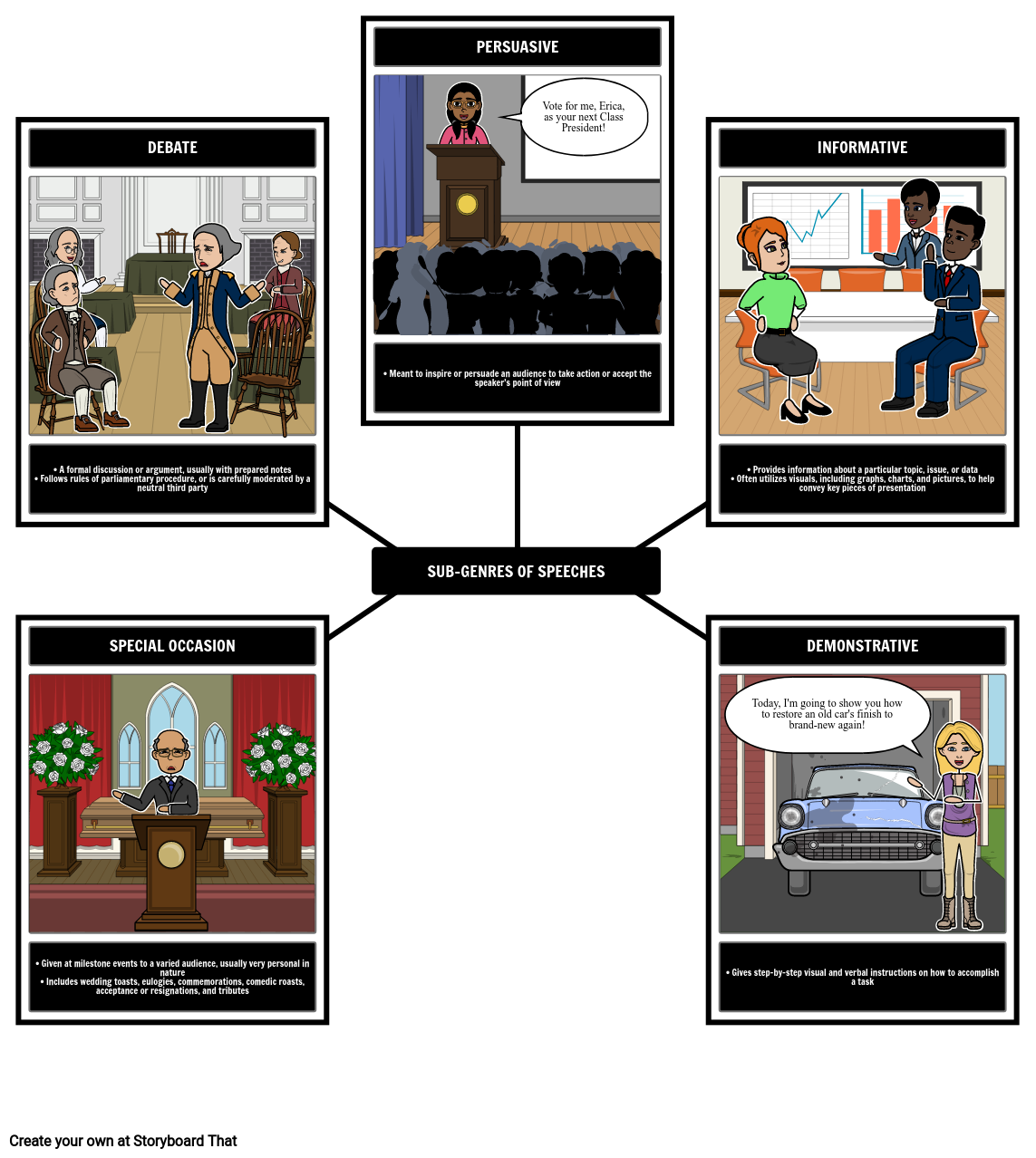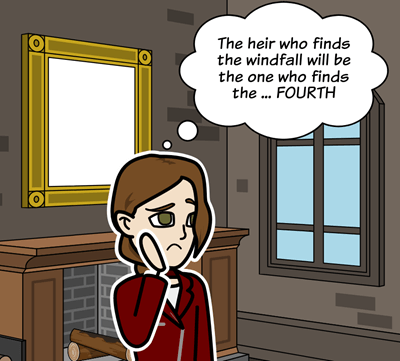Types of genres are categories of literature that are generally determined by technique, length, tone, and content. When we list literary forms in broader terms, they can be more abstract, flexible, and loosely defined. However, as we get more specific and into subcategories, the distinctions and rules of the genre become crystal clear.
What are the literature genres? Though we may think there are several types of written art forms, there are actually only 3 genres of literature. You may be wondering, what are the three genres of literature? Poetry, drama, and prose. That’s right. All the other genre types fit into one of these three categories. Students will typically encounter these narrative types of literature in English for most of what they read and write about in school. Therefore, they must be able to identify examples of literary artistic expressions, know their key characteristics, and list the genres of literature.
Keep reading to learn more about the different literary genres examples, along with ways for students and teachers to storyboard their forms of literature examples. In the genres of literature chart below, each of the storyboards and examples can be copied and used in an assignment with your students.
Literary Genres Examples
Here are some literary forms examples for you to check out. Different types of genres have different purposes. As you read through these examples, notice how the techniques, lengths, tones, and contents change.
Literary forms can be classified in many ways. In this section, we will take a closer look at 3 genres of literature: poetry, drama, and prose. Understanding the different classifications of literary expression in English will not only enhance your students’ reading experience but improve their writing skills too.
Types of Literary Genres
Poetry
Poetry is a genre of literature that uses aesthetic and rhythmic qualities of language—such as phonaesthetics, sound symbolism, and metre — to evoke meanings in addition to, or in place of, the literal or mundane meaning. Poetry has a very long history, dating back to prehistoric times with the creation of hunting chants and burial songs.
Among the different genre examples, poetry is considered by many to be the most intense literature genre. It allows a writer to express their deepest emotions and thoughts in a very personal way. It relies heavily on figurative language, rhythm, and imagery to relay its message to readers. Poetic writing uses beautiful language to express deep thoughts and feelings. Poetic expressions can help you understand your emotions and thoughts better, and it also helps you learn how to write more expressively.
Sub-Genres of Poetry
- Songs and Ballads
- Lyric
- Epic
- Dramatic
- Narrative
Drama
Drama is a mode of fictional representation through dialogue and performance. It is one of the kinds of literature which includes epic poetry, lyric poetry, and novel. Aristotle’s Poetics defines drama as “a representation of an action that is whole and complete and has a beginning, a middle, and an end.”
Drama is often performed on stage in front of a live audience, but it can also be presented in other forms, such as radio, film, and television. It is usually written by a playwright, although it can be adapted from other sources, such as novels, short stories, poems, or even real-life events. Or it can be read silently by individuals.
It contains dialogue, and actors impersonate the characters. Imaginary characters are frequently introduced to its narratives, allowing the playwright to explore complex human emotions and conflicts through both real-life and fantastical figures. Characters often encounter conflict, whether internal or external, as it serves as a driving force for character development and narrative tension. It is usually divided into acts or scenes and relies on props or imaginative dialogue to create a visual experience for the audience. Dramatic literary works are a good place to start, as they are usually pretty easy to understand at face value and captivates the audience with cliffhangers and mind-capitulating events.
Sub-Genres of Drama
- Tragedy
- Comedy
- History
- Melodrama
- Musical
- Novel
- Novella
- Short Story
- Myths and Legends
- Fables
- Historical Fiction
- Autobiography
- Biography
- Essay
- Diaries and Journals
- Narrative Nonfiction
- Poetry: Ballads, Lyric, Epic, Dramatic, Narrative
- Drama: Tragedy, Comedy, History, Melodrama, Musical
- Prose: Fiction (Novel, Novella, Short Story), Nonfiction (Autobiography, Biography, Essay)
- A Washington Post Newspaper Report of Hurricane Ian
- The short story called "The Fall of the House of Usher" by Edgar Allan Poe
- The historical fiction novel by Christopher Paul Curtis: Bud, Not Buddy.
- "The Miracle Worker" by William Gibson
- The famous play by the one and only William Shakespeare, “Romeo & Juliet”
- "Death of a Salesman" by Arthur Miller
- "The Road Not Taken" by Robert Frost
- "A Poison Tree" by William Blake
- "Still I Rise" by Maya Angelou
- What is the author’s purpose?
- Who is the audience?
- What are the main ideas?
- How does the structure help to emphasize the purpose?
- What literary devices are used and why?
- How does the author’s style contribute to the meaning of the text?
- How does the stagecraft contribute to the meaning of the play?
- What do the costumes and makeup tell us about the characters?
- How does the lighting help to create mood and atmosphere?
- What do the sound effects and music add to the play?
- What is the speaker’s tone?
- What is the poem's mood?
- What are the main themes of the poem?
- How does the poet use literary devices to create meaning?
- What is the poem’s form, and how does it contribute to the meaning?
Prose
This form of literary expression has no formal metrical structure. It applies a natural flow of speech, and ordinary grammatical structure, rather than rhythmic structure, such as in the case of traditional poetry. Prose is an example of literary text that is typically written in paragraphs, although there are some exceptions, such as in the case of drama or fiction.
Prose can be found in books, magazines, newspapers, online articles, blogs, etc. It is the most common form of writing. Examples of famous works of prose include To Kill a Mockingbird by Harper Lee & Charlotte's Web by E.B. White. The prose is simple, straightforward language. It can be either fiction or nonfiction. The prose is typically divided into paragraphs, and it uses regular grammar. It can be either serious or funny.
Fiction
Fiction is narrative writing that originates from the author’s imagination. It is designed to entertain, but it can also inspire, inform, or persuade.
Sub-Genres of Fiction
Nonfiction
Nonfiction is writing that is based on true events, people, places, and facts. It is designed to inform, and sometimes to entertain.
Sub-Genres of Nonfiction
What Are the Three Genres of Literature?
The main examples of genres in literature are poetry, drama, and prose. Poetry is a genre in literature that uses aesthetic and rhythmic qualities of language to evoke meanings in addition to, or in place of, the prosaic ostensible meaning. Drama is a mode of fictional representation through dialogue and performance. The prose is a form of language that has no formal metrical structure. It applies a natural flow of speech and ordinary grammatical structure, rather than rhythmic structure, such as in the case of traditional poetry. Genres of literature in English then fall into subcategories, which make up the three genres of literature.
Forms of literature examples are:
Genres of Literature Chart
A literature genres list would include categories like fiction, non-fiction, and folklore, but may also cover specialized types such as science fiction, romance, mystery, and historical fiction, offering a comprehensive overview of the literary landscape.
Genre types subcategories can be explained as the following:
Type | Definition |
|---|---|
| Ballad | A ballad is a type of poem that tells a story. Ballads are often about love, loss, or murder. |
| Lyric | A lyric is a type of poem that expresses the emotions or thoughts of the poet. |
| Epic | An epic is a long, narrative poem that tells the story of a heroic figure. |
| Dramatic | Dramatic poetry is a type of poetry that is meant to be performed. |
| Narrative | A narrative poem is a type of poem that tells a story. |
| Tragedy | A tragedy is a type of drama that ends in disaster for the main character. |
| Comedy | A comedy is a type of drama that ends happily or humorously. |
| History | A history play is a type of drama that tells the story of a historical event. |
| Melodrama | A melodrama is a type of drama that features exaggerated emotions and characters. |
| Musical | A musical is a type of drama that features songs and dance numbers. |
| Novel | A novel is a type of fiction that tells a long, complex story. |
| Novella | A novella is a type of fiction that tells a shorter, simpler story than a novel. |
| Short Story | A short story is a type of fiction that tells a brief, self-contained story. |
| Myth and Legend | A myth is a type of story that explains the origins of a culture or natural phenomenon. A legend is a type of story that tells the story of a heroic figure. |
| Fable | A fable is a type of short story that features animals as the main characters. |
| Historical Fiction | Historical fiction is a type of fiction set in the past and features historical figures and events. |
| Autobiography | An autobiography is a type of nonfiction that tells the story of the author’s life. |
| Biography | A biography is a type of nonfiction that tells the story of someone else’s life. |
| Essay | An essay is a type of nonfiction that expresses the author’s opinion on a topic. |
Different types of literature being classified by genres and subgenres help people better understand the diversity of literary styles, themes, and techniques employed by authors. Each type has its own purpose and style. Whether you’re looking for a light read or something more heavy and informative, there’s definitely a literary genre out there for you.
A Note About Speeches...
While not one of the primary genres of literature, speeches are important historical documents or moments and literature, and they don’t always fit neatly into one of the three primary genre categories. A speech is a formal address given to an audience. Speeches can be found in prose, drama, and poetry, and their primary goals are to persuade, inform, demonstrate, or entertain a reader, an audience, or other characters. They can also be used in nonfiction or fiction, depending on their purpose and use.
Why Use Storyboarding to Learn About Literary Genres Types?
Storyboarding is the perfect way to learn and remember the different genres of literature. When you storyboard, you can visually see how each literary genre differs from the next. You can also track and compare the subcategories within genres, identify key characteristics of each, and even explore the relationships between genres. All of this will help you better understand and remember the genres of literature, making it easier to identify them when you encounter them in your reading.
How Can Storyboard That Enhance the Learning Experience of the Three Genres of Literature?
Storyboard That can help students better understand the three genres of literature by providing a visual representation of each one. By storyboarding, students can identify key characteristics of each genre and see how they differ from one another. Additionally, Storyboard That is a great way to compare and contrast genres, as well as explore the relationships between them. All of this will help students better remember the genres of literature and be able to identify them when they encounter them in their reading.
Looking to add a little creative flair to your literature class? Check out Storyboard That’s easy-to-use, online storyboard creator! With our drag-and-drop software, you can create engaging, visually appealing graphic organizers to help your students learn about the different genres of literature. Plus, our easy-to-use tools make it simple to add text, images, and multimedia content to your storyboards, so you can really bring your lessons to life.
Where to Start When Learning About Literary Genres
If you’re just starting to learn about literary narrative types, the best place to begin is with the three primary genres: prose, drama, and poetry. These genres are the foundation for all other types of literature, so it’s crucial to have a strong understanding of them before moving on to anything else. Each genre will approach plot development, conflict resolution, and the art of delivering a satisfying conclusion in unique and captivating ways, reflecting the rich tapestry of literary expression.
In terms of choosing between the three, poetry tends to be the most complicated to understand as it can go against the usual laws of grammar. There are a lot of deeper meanings within poetry, so it can be hard to break down as a newbie. Start with some short, simple prose articles such as newspaper pieces and short novels.
When you start to get the underlying meanings behind the prose, you can then start to dive into some simple drama. Look into Greek tragedies and Shakespearean plays, as they are a great starting point. These genres will give you a better understanding of the basics before progressing on to more.
When you’re ready to go deeper, poetry is the next stepping stone. Children’s poetry is a great starting point to give you a good foundation of poetic structure and meaning. Then you can go further into complicated poetry, such as that of the Elizabethans and Victorians.
Once you feel comfortable with the three primary genres, you can start exploring the many subgenres that exist within each one. There are endless possibilities when it comes to different types of narratives, so there’s no need to rush. If you enjoy literature with comedic elements, begin by exploring the comedy genre.
Related Activities
Reading Material to Start With
Start with article number one and work your way down the list. When you are happy you understand each article within the genre, move on to the next set of articles.
Prose
Drama
Poetry
How to Get a Deeper Understanding
To get a deeper meaning of each genre, get your pen and paper ready and start to highlight the key ideas throughout. It can help to get your understanding of the writings by doing a summary for each one. Once you have done this, start to think about the following key things for each genre:
Prose
Drama
Plays can be trickier as you cannot always rely on the written word to give you all the information. This is where watching a performance of the play can come in handy, as it will give you a much better understanding. In addition to the above, when watching a play, you should also be thinking about:
Poetry
When reading poetry, it is essential to think about both the literal and figurative meanings of the words. This can be difficult at first, but there are some helpful strategies that you can use. For example, you can try reading the poem aloud or reading it multiple times. You can also look up words you don’t understand and try to break the poem down into smaller chunks. In addition to the above, when reading poetry, you should also be thinking about:
How to Put It All Together
Using a storyboard exercise like StoryBoard That can be helpful when trying to understand the genres. You can map out the key ideas and events for each one, as well as the literary devices that are used. This is a great way to see the genres side-by-side, compare and contrast them and visualize things better.
How to Host a Literary Genre Book Tasting in Your Classroom
Set up genre-themed stations around your classroom.
Label tables or desks with different genres like mystery, fantasy, nonfiction, and historical fiction. Use table tents or posters to define each genre.
Place 2–3 books or excerpts at each station.
Choose a mix of high-interest books that clearly represent the genre. Consider using short story collections, chapter book excerpts, or even printed blurbs.
Create a tasting menu or recording sheet.
Have students jot down the title, genre, a quick summary, and their “rating” or reaction after reading a sample from each station.
Play soft instrumental music to set the mood.
This helps establish a relaxed atmosphere while students rotate quietly between stations.
Rotate groups every 5–10 minutes.
Use a timer to keep things moving. Encourage students to discuss their thoughts briefly before moving to the next genre.
Debrief as a class and reflect.
Ask students which genres they liked best and why. Use their responses to help guide future reading selections or independent reading goals.
Optional: Decorate with café-themed props.
Low effort options like plastic tablecloths, clipboards as menus, and paper “genre snacks” can add a fun twist!
Frequently Asked Questions about Literary Genres
What are the main types of literary genres students should know?
The five core genres to introduce are: fiction, nonfiction, drama, poetry, and folklore or mythology. Within each category, you can explore subgenres like historical fiction, memoir, or fairy tales to help students make connections to texts they already know.
How can I teach literary genres in an engaging way?
Use visual aids like genre posters, anchor charts, and multimedia examples. Pair genres with popular books, movies, or short stories students already love. Try genre scavenger hunts, genre sorts, or create-your-own-book cover activities to make it interactive.
What's the difference between fiction and nonfiction genres?
Fiction genres are made up or imagined, like fantasy or realistic fiction. Nonfiction genres are based on real people, events, or information, such as biographies or informational texts. The key distinction is whether the content is invented or factual.
Can I use posters to teach literary genres effectively?
Yes! Genre posters are a powerful visual tool to reinforce definitions, examples, and key traits. They help students retain information and can be used as references throughout the year in reading and writing units.
Why is it important for students to understand literary genres?
Understanding genres builds critical reading skills. It helps students make predictions, recognize text structure, and better comprehend what they read. It also gives them tools to write in different styles.
How do you introduce genre to elementary students?
Start with stories they already know and ask guiding questions like, “Could this really happen?” or “Does this story teach me something true?” Use anchor charts, genre read-alouds, and sorting games to reinforce learning.
What are some fun activities to help students learn genres?
Try matching games, genre-themed book tastings, genre scavenger hunts in the classroom library, or “Guess the Genre” challenges using short story blurbs or images.
Do you have a printable chart or template for literary genres?
Yes! Storyboard That offers genre anchor charts, printable posters, or graphic organizers that summarize literary genres with definitions and examples. Look for customizable versions you can tailor to your classroom.
© 2026 - Clever Prototypes, LLC - All rights reserved.
StoryboardThat is a trademark of Clever Prototypes, LLC, and Registered in U.S. Patent and Trademark Office








